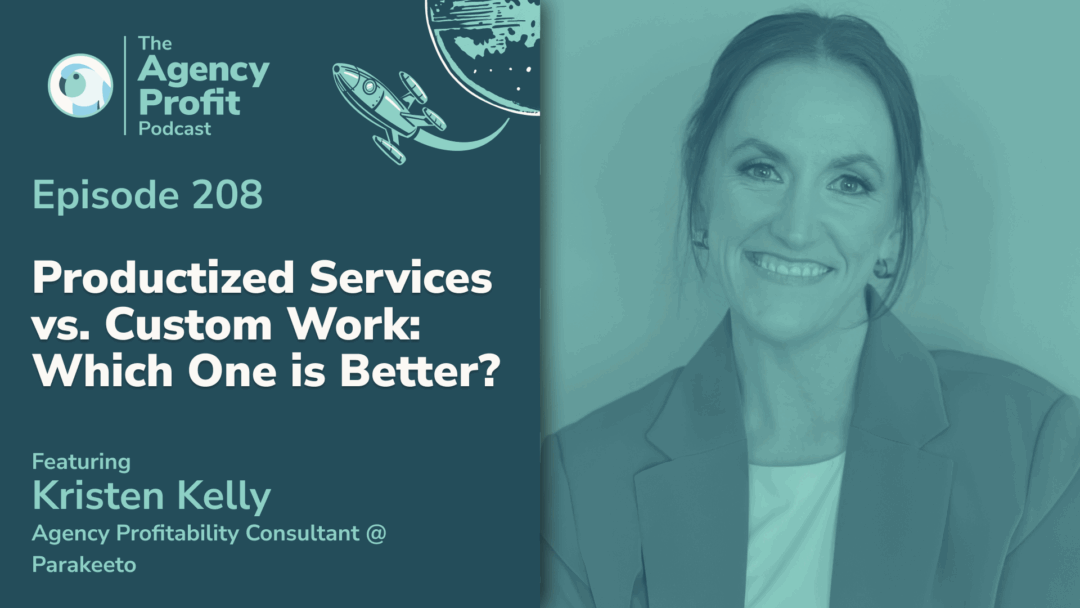About the Episode:
In this episode of Agency Profit Podcast, Chip Griffin shares his expertise in scoping projects and protecting profit margins on client work. This episode breaks down everything you need to know to properly scope projects, create your budgets, evaluate the cost aspect of a project, reduce scope creep and much more!
About Chip:
Chip Griffin is dubbed as “The Agency Whisper” in the industry. He’s the host of the Agency Leadership Podcast and Chats with Chip and helps PR and marketing agencies reach their goals and increase their efficiency.
Chip became the CEO of Townhall.com when he was in his early twenties. And since that time he has built and sold several companies, both in tech, and he started and sold several agencies and consultancies. Today he spends his time educating, coaching, consulting, and speaking to agency owners on how to run and scale their agencies.
Want to see more of Chip? Follow him online:
Resources
Timestamps:
Intro 0:00
How did Chip go from Building and Selling Businesses to
Coaching Businesses? 3:28
How to Properly Scope Projects and Create your Budgets 6:04
When Should an Agency Evaluate the Cost Aspect of a Project 8:35
Scoping and creating accurate budgets inside your agency? 11:59
Expenses that Agencies Must Watch Out For 13:57
Contingency Reserves Based on People’s Risk 14:52
How to Reduce the Amount of Scope Creep Once
the Projects Gets Underway 24:08
Gross Profit Margin Target for Agencies 25:11
Core Principles to Remember in Managing Relationship with a Client 36:55
Outro 44:21
How to Scope Projects & Protect Profits with Chip Grifin – Episode 28
The foundation of running a successful agency lies in charging more money to clients than it takes for us to deliver outcomes to them. Ideally, we’re consistently achieving 50-70% gross margins on projects, which sets us up to have reasonable overhead and continue to cash-flow our growth.
Unfortunately, we’ve all found ourselves losing our shirts and in some cases even spending money to work with a client. Most often, the culprit is a combination of poor scoping and scope creep leading to a dumpster fire of a project that leaves us with lots of work to do and very little profit to show for it.
For some of us, this still happens more often than we’d like to admit.
That’s why I decided to invite my friend Chip Griffin onto the show to share his knowledge and experiences in scoping projects and protecting profits.
He didn’t disappoint, as he broke down what he’s learned from years of running and scaling his own agencies to multiple exits, and helping clients do the same.
How to Properly Scope Projects and Create Your Budgets
There are a lot of factors that play in when properly scoping projects and creating budgets. It’s a complex process that often requires some analytical savvy.
According to Chip “The agency community is filled with really creative people who are fantastic at client service, but a lot of them just don’t have a lot of business experience.”
It comes as no surprise that many of the agencies I speak to have a difficult time getting a handle on scoping, and spend most of their careers feeling like they’ve never found a reliable way to do it accurately.
When it comes to getting a handle on an estimate, Chip states that agency owners must create a project plan with their clients that will be beneficial for both parties. From billing clients based on an hourly rate, flat-rate pricing, or value-based pricing; there are a lot more factors that you, as an agency owner must take into consideration.
So it becomes increasingly important to get really good at figuring out how much or how long will it take to deliver the project with our desired outcome to our clients while making sure to stay within the budget and submitting them on-time. This means tracking actuals against estimates overtime to feed that information back to whatever supporting data/documents you might use to create estimates in the first place.
With that being said is it important to answer these questions before signing a contract to a client:
- How long will this project take?
- Do I need to hire new people?
- How much will all these expenses cost?
- Have we done this kind of work before?
- How much uncertainty exists around what the client is asking of us?
- What’s our gut-feel on the client, and how demanding they might become?
- Do I need to travel to meet up with my clients or remote employees?
- Are we importing assets/materials from the client?
- Will I be able to deliver and accomplish my clients’ expectations?
- What type of billing method is most beneficial for my agency and the client?
- etc.
Being thorough in the discovery process and really assessing the risk of a project is key in establishing the right level of contingency and padding in your estimation.
Chip is also a big fan of doing paid discovery, giving you the ability to get compensated for the time it takes to properly assess your client’s needs.
Project Budgeting for Accurate Profitability
If you want an overall profitable business, you need to sit down and take note of all the expenses and other factors into consideration before pricing a project. This will drastically help in determining how much it will cost because as I’ve stated earlier it can’t just be about dollars and cents.
It is more about coming up with the scope and if you’re putting together a budget that will help you think about the scope and what you’re going to deliver to your clients.
According to Chip, he has seen a lot of agencies that start doing value-based pricing or they start doing flat-rate pricing and then since they do not have any use for timesheets when billing their clients they throw them away. Often, they also abandon the idea of actually assessing the client’s needs thoroughly in the sales process.
For example, a client is willing to pay us $100,000 to build their website, and they have certain expectations, of course, like they want the website to look or function a certain way or they want the website to be up and running on this specific date.
But, based on the client’s expectations and factor in the cost and time to deliver their expectations, will this project still be profitable for my business?
Chip states that it’s important to dig deeper into what point their agency should start to evaluate the cost aspect of a project. At what point in that sales cycle should they start to have that conversation, and who should generally be involved in that conversation to make sure that the estimate is actually realistic, accurate, and transparent to all the stakeholders.
When Should an Agency Evaluate the Cost Aspect of a Project?
Chip advised that agency owners need to do a thorough cost evaluation of a project before giving the client a price. And based on his experience, a lot of agencies don’t go about building a budget for their projects, and if they do, they do it after they’ve already submitted the proposal, the scope, and the price.
And, when you’ve got the contract in place, but it turns out the fund is not sufficient to be able to run the project successfully can be a tad bit stressful to deal with. So you really need to have it in advance.
“I’m not saying that you should take the budget and price solely based on it, instead the budget should be used to establish the minimum or maximum amount that you can charge for this project in order to be profitable.” he says
“That doesn’t mean that you shouldn’t charge more than that, because you also want to charge for the value that you’re delivering. It’s a very popular way to do agency pricing now, but you need to know what that bottom line is, that you just simply can’t go below without.”
It is extremely important that you involve the people who are going to manage the project in the budgeting process. This way, you will be sure that everyone understands the scope of a certain project and how they can be more efficient to be able to work on another project.
It’s also important to get those different ideas out on the table so that you can try to figure out what is a reasonable expectation for this particular piece of work or this particular process that this project needs to be successful.
Creating Accurate Budgets Inside Your Agency
According to Chip Griffin, the first thing agency owners need to do is to start creating these budgets. They also need to make sure that they are closely monitoring and collaborating with their project managers to determine the factors that block their progress. And to create an accurate agency budget you must consider these factors:
- Cost of Labor, you’ll be surprised that agencies miscalculate the cost of labor. Quite frankly, labor is by far the largest expense for just about every agency out there. And estimating your agency’s labor time is challenging, and you need to consistently ask and get feedback to improve.
Click here for our blog post on calculating Labor Cost-Per-Hour.
- Pass-Through, Production & Travel Costs, Of course, it’s also critical to factor in the more obvious costs to delivering a project. Things like contractors, equipment rental, material costs, ad spend, etc.
One of the things that a lot of business owners forget to put in a budget is the travel costs related to client work, and particularly as more agencies are virtual and more people are having clients who are not just a car to drive away.
Chip recalls a specific example: “I had a client who would pay me $75,000 annually with a condition to fly to Australia on a bi-monthly basis, but when I started digging in and it turned out that I was spending $15,00 to $20,000 a year on travels alone. And, all of a sudden, there’s 10% or so of the revenue being eaten up just by travel costs.”
Make sure you’re thinking about all the costs of delivering outcomes to the client and maintaining your relationship with them.
Contingency Reserves Based on People’s Risk
Chip has seen a lot of agencies estimate with their rose-colored glasses on. He says the first thing you need to do is create a budget without being wildly optimistic about how quickly you can get things done. It’s more important to be realistic, instead of conceptualizing an “ideal word scenario” where everything goes as planned.
As we all know, they rarely do.
Chip recommends having contingency factored into estimates based on the level of uncertainty around the work. Often, this will come down to how many times it’s been done in the past, and how consistent it was in scope. The objective should be to get estimates within 10% of reality over time.
This is why having a cadence in place allows you to monitor how much time did it actually take to complete the project versus how long did you estimate the project is going to take and adjust estimating processes & documents accordingly.
Another thing that you need to consider is building your agency’s culture and the rules on defining your initial scope of work. There’s a wide range of agency approaches to this. And, in general, there’s a lot of over-servicing that takes place.
I personally believe in the importance of time tracking inside of an agency, because you will be able to get insights as to whether you are doing well or not, which can be challenging to estimate when you’re using a flat-rate or value-based pricing.
And then that brings me to another point, which is the way that you structure your projects or deliverables or tasks within a time tracking software is important because it’s like setting up your chart of accounts inside of your agency. Because, you need to track cost, not with a blended rate.
Chip stated that “I know it’s really popular in the agency world to charge clients a blended rate, and that’s fine, but from a budgeting perspective, you need to make sure that you’ve got at least several bands. I’m not saying you need to go in and figure out each employee’s individual costs and all that, but have at least three bands so that you can appropriately account for the different types of workers that you’ll have on a project because it’ll make a huge difference in your pricing and profitability.”
If you want to make sure that it’s not leaving money on the table. Make sure you do that piece of it.
Side note: our Agency Profit Toolkit is a one stop shop for you to be able to outline some of these crucial profitability numbers to a potential buyer. Spreadsheets, templates and training videos, you name it, it’s all in the toolkit. Grab yours free at the link below:
Core Principles to Remember in Managing Relationship with a Client
The core principles that are really important when it comes to managing that relationship with your client:
- Having a backbone with a client that sometimes has a little too much power from an economic perspective in their business.
- Start by thinking about how you’re structuring your client base and making sure what type of clients you’ve got. It’s generally better to have a bunch of clients all in the same range than have small ones and big ones mixed together. Because that tends to create an imbalance.
- You need to be creating a culture in which the team is comfortable withdrawing the line with clients. Often, overservicing occurs when the client asks a team member to do something directly, and they do it without ever running it up the chain of command for approval.
- Establish an organized and easy-to-follow way of time tracking.
- Use resource planning to make sure you’ve got the right people protected for the right amount of time to deliver expected outcomes to the client.
- Establish a clear process for communicating and approving changes in scope, and processing requests from clients for changes/additional work.
The point of all of this is to learn how to create better systems in your business to become more efficient. To create processes that can scale, that can be repeatable, that can protect your margins, protect your team’s time, and ultimately give you a business that is sustainable in the long term.
And ultimately this all comes back to communication. It’s ironic that in an industry where communication and collaboration is the key to success, communication tends to be the place where things break down.
You need to have good communication amongst your team members and between your agency and the client. And the more of this communication that you have, the more accurate your budgets are going to be, the more accurate your scopes of work are going to be. The better your profitability is going to be.
Agency Profitability Tool Kit
If you’re looking for more resources to help you improve your agency’s profitability, then check out the Agency Profitability Tool Kit – it’s full of the same templates and checklists we’ve used with consulting clients to help them improve their profitability by over 100% in under 60 days.








0 Comments